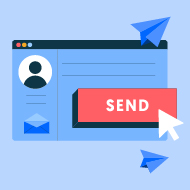This article is part of the Crunchbase Community Contributor Series. The author is an expert in their field and a Crunchbase user. We are honored to feature and promote their contribution on the Crunchbase blog.
Please note that the author is not employed by Crunchbase and the opinions expressed in this article do not necessarily reflect official views or opinions of Crunchbase, Inc.
Lead generation is vital to the growth of any B2B company. So whether you’re just starting out or your business is seeing a lull in new clients, you may be tempted to buy a B2B lead list.
Many online articles will tell you that you should never buy a B2B lead list, but that’s not always true. In this guide, we’ll dive into some essential tips if you’re considering buying, renting or building a B2B lead list.
Build your own B2B lead list.
Grow your revenue with all-in-one prospecting solutions powered by the leader in private-company data.
What is a B2B lead list?
A B2B lead list is a list of companies that your business wants to acquire as customers. The list will have company names, decision-maker names and roles, email addresses, phone numbers and further details such as industry or their LinkedIn profile.
This list can then be used by your marketing teams or sales team to get in touch with potential customers. B2B lead lists are essential for many businesses as lead generation is often one of the top priorities for B2B companies.
When to buy a B2B lead list
Buying a B2B lead list is a quick way to generate new B2B leads for your business. That said, it has a bad reputation and often, with good reason. Purchased B2B lists are often seen as low-quality, inaccurate and may not have undergone data cleansing.
That said, purchasing a B2B lead list can be especially useful for building a high-growth startup or expanding small businesses as it can quickly give you a list of potential clients with very little hassle. You just have to make sure to do your research.
How to buy the best B2B lead list
If you’ve decided to buy a B2B lead list, it’s important you keep the following three points in mind.
1. Know who your target customers are
Some B2B lead lists are filled with generic leads to suit many different companies; this can be a huge waste of money. Instead you should have a clear idea of your target market and communicate it to your lead vendor.
If you’re unsure of who your target audience for marketing and sales campaigns are, now is the time to figure it out. The best approach is to rank your current customers and create an ideal customer profile. This will help your lead vendor understand who you are targeting, and what role the decision-makers you need to reach are in.
2. Look for consultative list providers
Quality over quantity is an essential part of finding high-quality leads from B2B lead list providers. Some lead vendors will try to sell you as many leads as possible and your relationship ends there. These leads will be less likely to help your business.
Instead, find lead list providers that are consultative too. That means they will speak with you about your needs and target audience and will offer their insight before providing leads.
3. Spend more on high-quality leads
High-quality leads aren’t the cheapest leads out there. They are targeted, up to date and accurate. No matter how tempting it is to buy the cheapest leads out there, in the long run you’re better off spending more and investing in a high-quality lead list.
One company found that low-quality lead lists end up being 60 percent more expensive than high-quality lead lists due to the time spent cleansing lists and the amount of dead leads.
Nowadays, many lead generation companies offer monthly plans rather than one-off payments for a lead list. They provide regularly updated, high-quality lead lists on a monthly basis, which can be much more cost-effective than buying a one-off and potentially outdated list.
4. Be clear on the legalities
Many countries have particular rules about data—from GDPR in Europe, to CAN-SPAM in the U.S. Make sure you’re familiar with the rules before you buy, and check that the company you purchase from has met the requirements for the location in which you plan to use the list.
Upload lead lists. Get alerts.
Upload existing lead lists to Crunchbase to get automatic alerts when your leads raise funding or trigger a key buy signal.
Alternatives to buying a B2B lead list
If you’re still unsure about buying a B2B lead list, here are two main alternatives:
Build your own B2B lead list
A popular alternative to buying a B2B lead list is to build your own. This can be done yourself, either internally or via a lead-generation platform. Creating your own lead list may sound daunting, but it can be far more cost-effective and targeted than purchasing leads—especially if you’ve already purchased leads in the past.
One example of how to build your own B2B lead list is to use visitor identification software on your website that will show you who is visiting your website—a common buying signal— and provide their business details. It’s important that you have a website that potential leads can find and will click on.
Hire a lead-generation service
Another approach to lead generation is to hire a consultant or work with a dedicated service. While this is more expensive than buying or renting a lead list, it is more likely to provide you with high-quality leads with a high conversion rate.
For example, if your business provides enterprise VoIP solutions, you can work with a lead-generation consultant to ensure that the leads you pay for are with large companies rather than small businesses.
How to use a B2B lead list
No matter how you acquired your B2B lead list, let’s dive into how to use one.
1. Cleanse your lead list
This step is especially important if you bought a lead list rather than building your own. Start by spot-checking your lead list to ensure contact details are accurate, up to date and relevant. If you’re spotting lots of inaccurate leads, get back in touch with your leads vendor.
You may also want to rank your leads according to their relevance, quality and likelihood to convert by doing some prospect research.
2. Plan your marketing campaign
Next, think about how you’ll use these leads. Do you plan on sending out a mass marketing email to everyone on the list or contacting each lead individually? Will you cold call each contact? Plan out your campaign for actioning the contacts on the list.
3. Start with soft outreach
Cold emails can be off-putting. Rather than aiming for a sale right away, start with soft outreach. This gives you a chance to make contact with a potential client, offer something of value, and begin to form a relationship.
For example, imagine you sell call center technology. Rather than sending them an advert for your product, email them with a more useful, less “salesy” marketing email, such as a link to a blog post about how to start a virtual call center.
Is buying a B2B lead list right for your business?
Buying a B2B lead list has its advantages—it’s a cheap and easy way to get a list of leads for your marketing and sales teams. Building a lead list yourself or using lead generation platforms are more expensive options, but often are more effective. Whatever option you choose, so long as you do your research and understand your own needs and target audience, you’ll be able to make the most of B2B lead lists.


Jessica Day is the senior director for marketing strategy at Dialpad, a modern cloud PBX system that takes every kind of conversation to the next level—turning conversations into opportunities. Day is an expert in collaborating with multifunctional teams to execute and optimize marketing efforts, for both company and client campaigns. See more about her on LinkedIn.






